AGRA FORT
AGRA FORT
• INTRODUCTION TO THE AGRA FORT
Agra Fort is a historical fort in the city of Agra in India. It was the main residence of the emperors of the Mughal Dynasty till 1638 when the capital was shifted from Agra to Delhi.
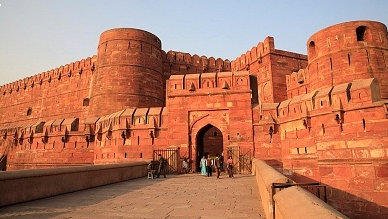
ENTRANCE TO THE AGRA FORT
The Agra fort is a World Heritage site. It is about 2.5 km northwest of its more famous sister monument, the Taj Mahal. The fort can be more accurately described as a walled city. I have had the privilege of visiting this incredible monument. It is said that this fort had a lot of underground chambers which were destroyed by invaders including Jats, British and Marathas.
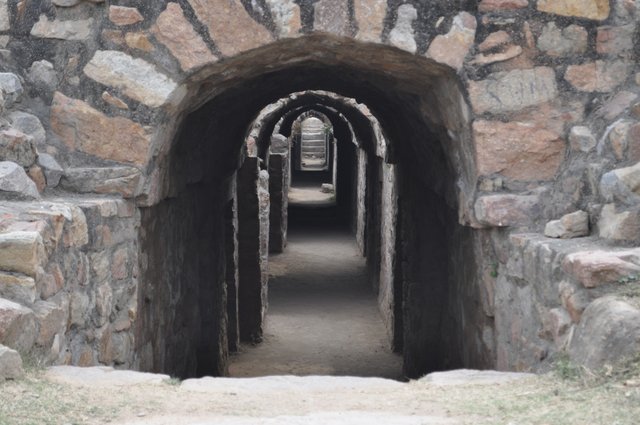
HIDDEN UNDERGROUND TUNNEL IN THE AGRA FORT
Later,The British used this fort as their garrison. Even today, a large part of this fort is restricted to army usage. At the edge of the fort, you can find the octagonal tower in which Shah Jahan was held as a prisoner by his son as he requested that he wanted to spend his life looking at Taj Mahal. The reason as to why his son imprisoned him was because of the amount of money he was wasting on the construction of buildings.
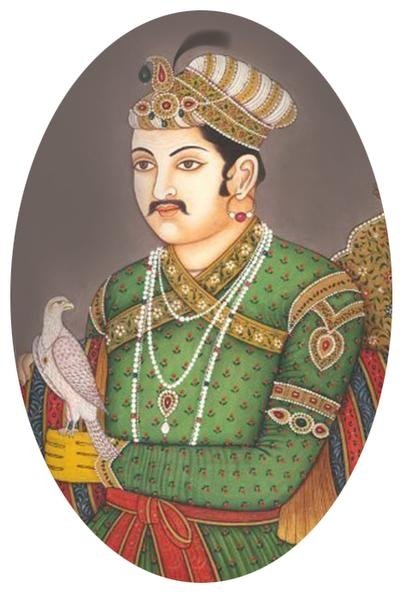
JALALUDDIN AKBAR
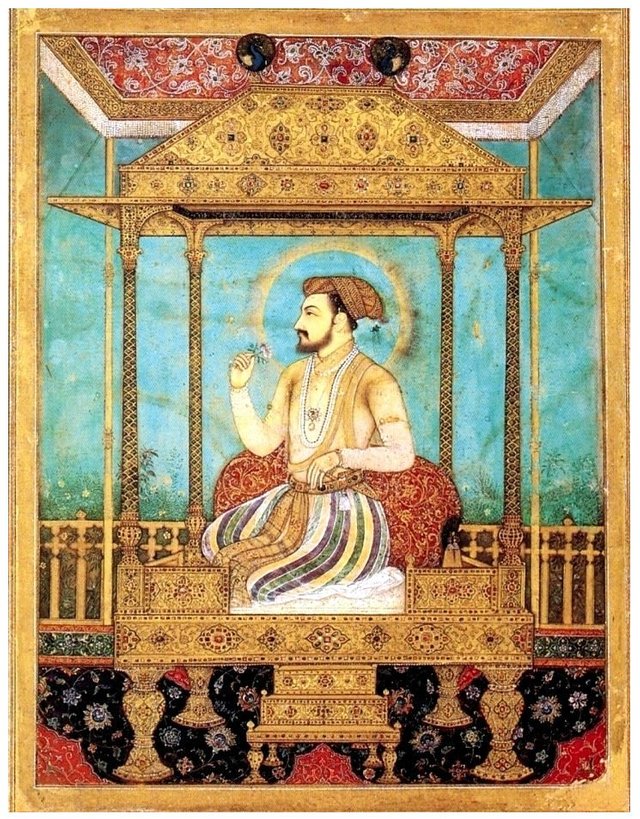
SHAH JAHAN
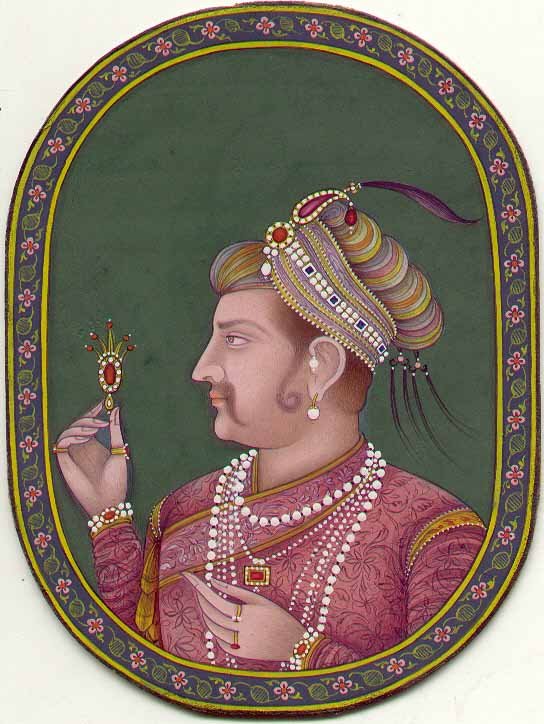
JEHANGIR
The Agra Fort contains extremely magnificent palaces both in red sandstone and white marble built by two generations of historic builders Akbar and later Jehangir and Shahjahan.

THE OCTAGONAL TOWER SHAH JAHAN WAS HELD CAPTIVE AND DIED IN.
• WHERE IT ALL BEGAN
The history of the Agra fort all started after the first battle of Panipat in 1526.

THE FIRST BATTLE OF PANIPAT IN 1526
People at that time did not have many machines or maybe no machines at all. But they had their brains. They were so intelligent that at night if an enemy tried walking or breaking in to the fort, they made hollow walls so that they can here the footsteps of the enemy.
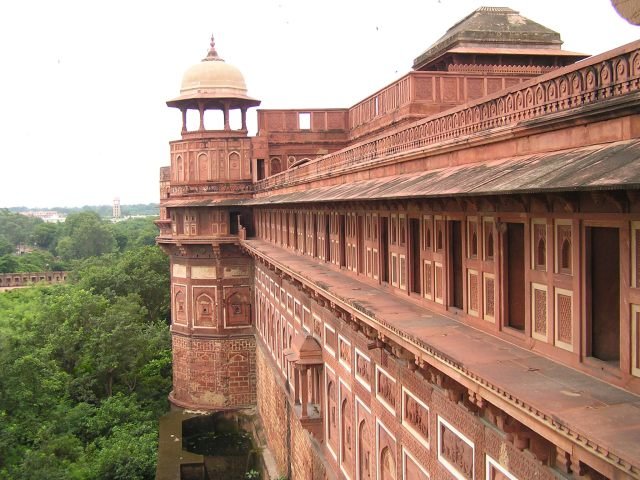
OUTSIDE WALLS OF THE FORT
They also had many different ways of killing the enemy if they broke into the fort. They had these path ways running down the hollow walls where they can pour hot, burning oil down it onto the floor so that the enemy slips and falls flat onto his face so that he gets burnt and feels excruciating pain and eventually dies through the heat of the oil that is burning him and the immense pain he is feeling. The emperors and kings did not pity anybody. If they did something wrong they were punished severely. The Fort is built on the Jamuna River which is used as a natural air conditioner for the emperors and their families. It is often very cold at the fort because of this reason
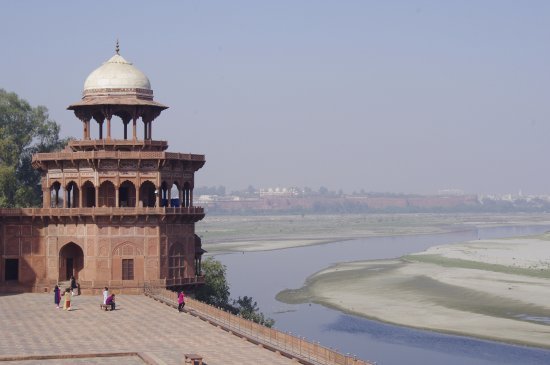
THE AGRA FORT BUILT ON THE JAMUNA RIVER, A NATURAL AIR CONDITIONER
The victorious Babur stayed in the fort until he was defeated at Bilgram in 1540 by Sher Shah Suri. The fort remained with the Suris until 1555 when Humayun recaptured it.
Realising the importance of the situation, Akbar made it his capital and arrived in Agra in 1558. It was in a ruined condition and so Akbar decided to re build it with the use of red sandstone from the area of Barauli. Approximately 4000 workers worked on the construction of this monument daily which took them 8 years, completing it in 1573.
It is only because of Akbar’s grandson Shah Jahan that this historical monument took on its current state. Shah Jahan built the magnificent TAJ MAHAL in memory of his loving wife Mumtaz Mahal.
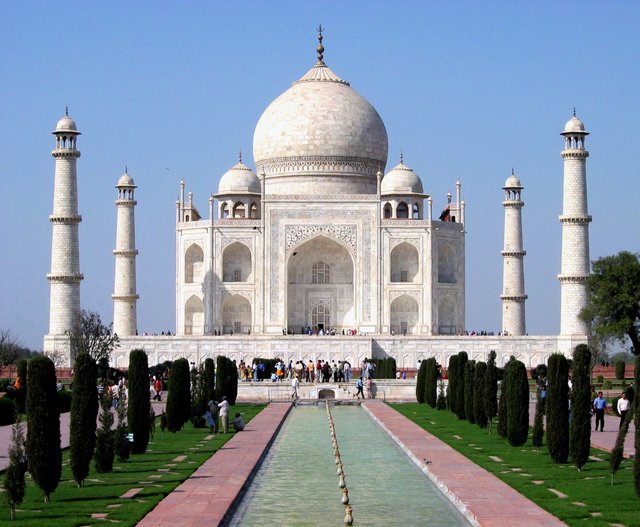
THE TAJ MAHAL
Shah Jahan was widely considered to be the most competent of Emperor. Shah Jahan wanted all of his buildings to be built out of pure white marble. Shah Jahan had a balcony in the Agra fort where he would look at the Taj Mahal and pray to his wife as the Taj Mahal was her burial site.The Taj is also built on the Jamuna river and can be seen from the agra fort. The real tombs cannot be seen at the Taj Mahal by anybody as it is under ground. Instead they created a duplicate tomb for the public to see. It is decorated with diamonds and gems; it is also made out of pure white marble. It is rumoured that Shah Jahan died in Muasamman Burj which is known to be a tower made out of pure white marble with an astonishing view of the Taj Mahal.
The Fort was then later invaded and captured by the Maharata Empire in the early 18th century. The fort is surrounded by a large amount of water which were the homes of crocodiles and alligators.
• LAYOUT OF THE FORT
The fort is approximately 380 000 square feet which is about 94 acres of land.
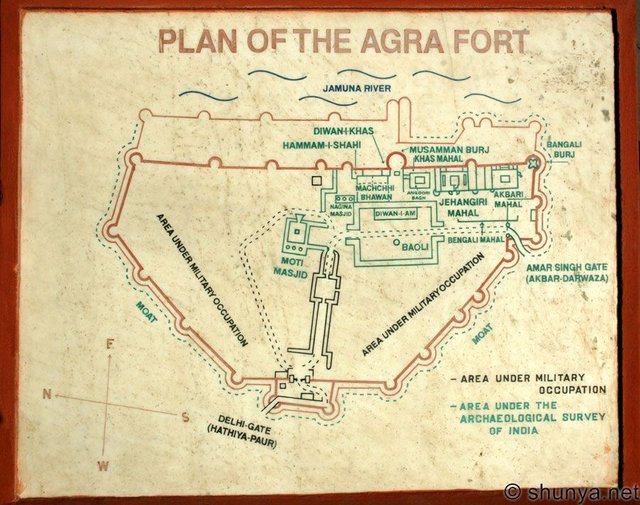
PLAN OF THE AGRA FORT
Four gates were on the four sides of the fort. One khrizi gate opening on to the river. The Lahore gate is popularly known as the AMAR SINGH GATE for Amar Singh Rathore.
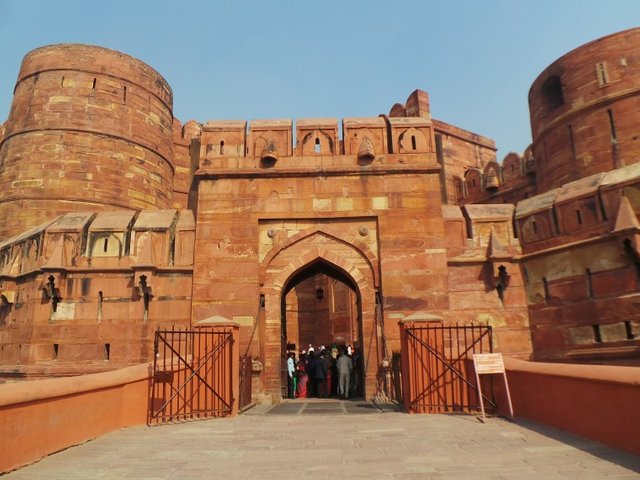
AMAR SINGH GATE
The Dheli gate, which faces the western side of the fort, is considered the grandest of all four gates and a masterpiece of Akbar’s time. It was built to enhance security and was used as the king’s formal gate.
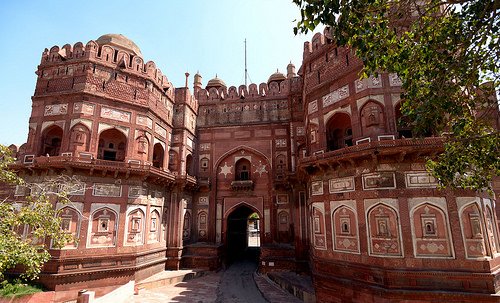
DHELI GATE
The wall of the Agra fort lies parallel to the river and is 70 feet high. It included features related to both. The gate is guarded by two life sized stone elephants to increase security.
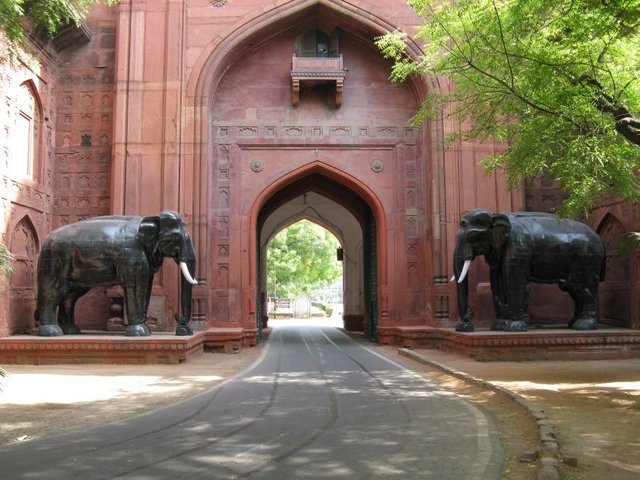
LIFE SIZE STONE ELEPHANTS AT THE DHELI GATE IN THE AGRA FORT
A drawbridge is needed to cross over the large amount of water in order to enter the Fort.
During an attack to the Fort, enemies would use elephants to destroy the gates.
Because the Indian military is still using the northern portion of the Agra fort, the Dheli gate cannot be used by the public.
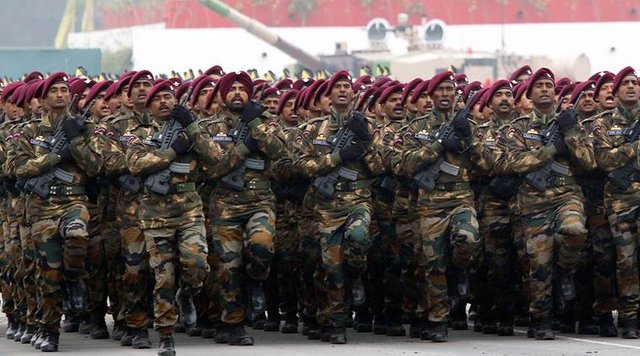
INDIAN MILITARY
The site is very important in terms of architectural history. Abul Fazal recorded that five hundred buildings in the beautiful designs of Bengaland Gujarat were built in the fort. Some of them were demolished by Shah Jahan to make way for his white marble palaces. Most of the others were destroyed by the British between 1803 and 1862 for raising barracks.
Akbar Darwazza (Akbar Gate) was renamed Amar Singh Gate by the British. The gate is similar in design to the Delhi Gate. Both are built of red sandstone.
• TOURIST ATTRACTION
Today, nearly 10000 people visit the Agra fort per day and is open everyday. They employ people to clean and make sure the fort is in a good state and is not tampered with in any way. Many people around the area that are tourists often visit this historic monument as it is known for its history and because it was the home of the Mughal Dynasty till 1638.
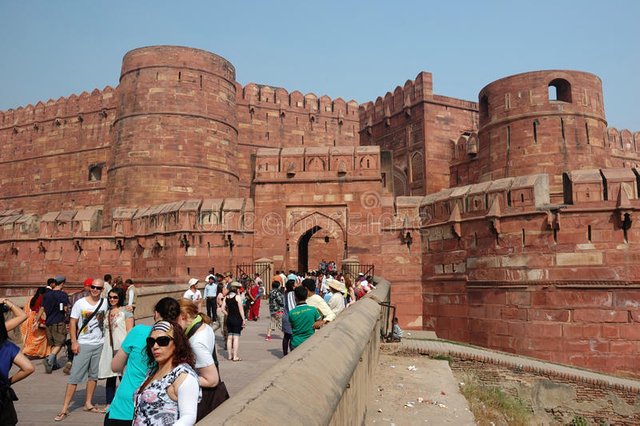
TOURISTS AT THE AGRA FORT
• MONUMENTS WITHIN THE AGRA FORT
1. THE KHAS MAHAL:
The Khas Mahal is an airy imposing building, overlooking the specially laid Angoori Bagh which is a grape garden, a simple formal Mughal Garden. Closed windows with decorative stone screens present an astonishing view of the riverfront.
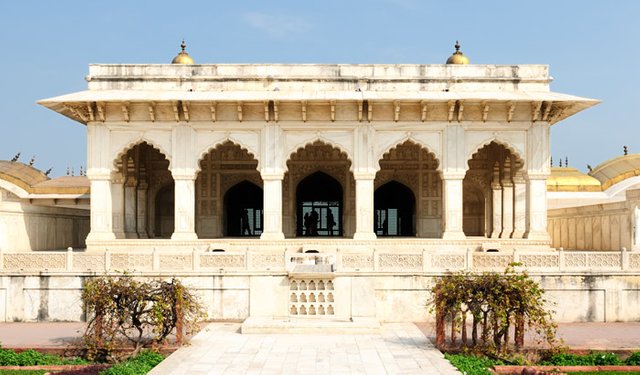
THE KHAS MAHAL
2. MUSAMMAN BURJ:
The Musamman Burj is within the fort, where the queens {NURJAHAN and MUMTAZ MAHAL} lived. Shah Jahan was also held captive here by his son and he unfortunately died here, looking at the Taj Mahal.
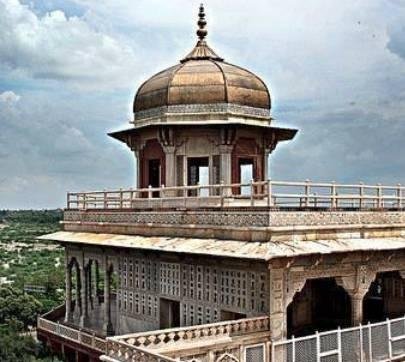
MUSAMMAN BURJ
3. DIWAN I KHAS {HALL OF PRIVATE AUDIENCE}:
This was built by Shah Jahan in 1636-1637. It is a small hall with 2 pure white marble columns with a pietra dura decoration. Here the Mughal emperor received important messages from foreign ambassadors. On the balcony of this hall is a throne. The throne was made black in the rebellion against Akbar.
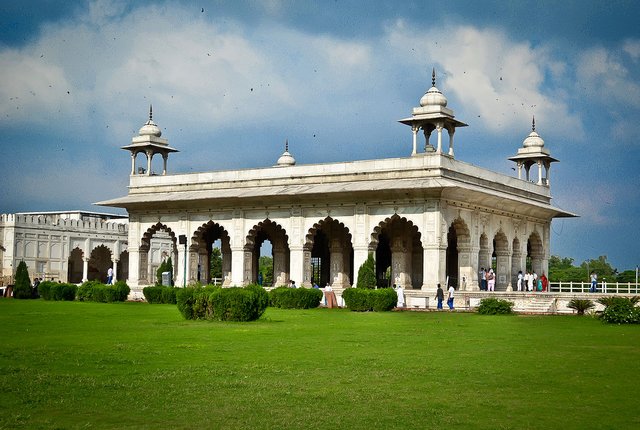
DIWAN I KHAS {HALL OF PRIVATE AUDIENCE}
• THE AGRA FORT IS ALSO KNOWN FOR:
• The Agra Fort won the Aga Khan Award for Architecture in 2004. India Post issued a stamp to commemorate this event.
• The Agra Fort plays a key role in the Sherlock Holmes mystery The Sign of the Four, by Sir Arthur Conan Doyle.
• The Agra Fort was featured in the music video for Habibi Da, a hit song of Egyptian pop star Hisham Abbas.
• Shivaji came to Agra in 1666 as per the "Treaty of Purandar (1665)" entered into with Mirza Raje Jaisingh to meet Aurangzeb in the Diwan-i-Khas. In the audience, he was deliberately placed behind men of lower rank. Insulted, he stormed out of the imperial audience and was confined to Jai Sing's quarters on 12 May 1666.
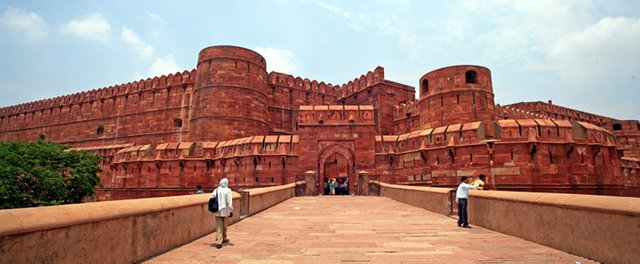
AGRA FORT
In conclusion I would like to add that the Agra Fort is a really magnificent place with a lot of history and engineering required in order to build it and have such an exquisite strategy when it comes to war. Thank you for taking time to read my post.
I hope you have enjoyed.
Please make sure to upvote, resteem and follow for more posts like these.
Thank you so much for your support.
/thank-you-185078737-58adfa013df78c345b0837e7.jpg)
THANK YOU!!!!!!!
verry good!
vote up me to!
https://steemit.com/@usmanjutt up vote me i also upvote you
@usmanjutt i have upvoted you...
Vote me up too ..
I like your posts ..
awesome and the part of historical culture.
Good job done by you @suravsingh
follow me @hamza77
THANK YOU @hamza77 . i have followed you
Most Welcome @suravsingh
https://steemit.com/@usmanjutt
https://steemit.com/@usmanjutt my link
Very interesting post, nice pictures and nice text, thank you for the trip ...
thank you @marie2018
Hello @suravsingh
I really like your steemit account. Would you like to teach me how to create a steemit account I advanced like your account ???
👍
Very interesting post :) @suravsingh
thanks @jrrp
Next interesting place in India...
hi @danielmarkiewics.
i will soon be writing on more historic places in india. please make sure to follow so that you don't miss out.
I will appreciate you for more articles about historical places @suravsingh
i will soon be writing on more historic places in india @hamza77. please make sure to follow me so that you don't miss out
@suravsingh i have followed you :)
Upvote me up too..
impressive :)
thank you @wargliis